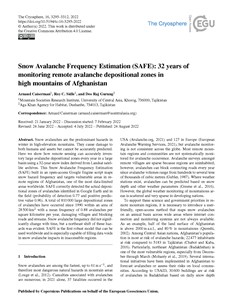Snow Avalanche Frequency Estimation (SAFE): 32 Years of Monitoring Remote Avalanche Depositional Zones in High Mountains of Afghanistan
Published: The Cryosphere, 16, 3295–3312, 2022
https://doi.org/10.5194/tc-16-3295-2022
© Author(s) 2022. This work is distributed under the Creative Commons Attribution 4.0 License.
Abstract
Snow avalanches are the predominant hazards in winter in high-elevation mountains. They cause damage to both humans and assets but cannot be accurately predicted. Here we show how remote sensing can accurately inventory large avalanche depositional zones every year in a large basin using a 32-year snow index derived from Landsat satellite archives. This Snow Avalanche Frequency Estimation (SAFE) built in an open-access Google Engine script maps snow hazard frequency and targets vulnerable areas in remote regions of Afghanistan, one of the most data-limited areas worldwide. SAFE correctly detected the actual depositional zones of avalanches identified in Google Earth and in the field (probability of detection 0.77 and positive predictive value 0.96). A total of 810 000 large depositional zones of avalanches have occurred since 1990 within an area of 28 500 km2 with a mean frequency of 0.88 avalanches per square kilometre per year, damaging villages and blocking roads and streams. Snow avalanche frequency did not significantly change with time, but a northeast shift of these hazards was evident. SAFE is the first robust model that can be used worldwide and is especially capable of filling data voids in snow avalanche impacts in inaccessible regions.



